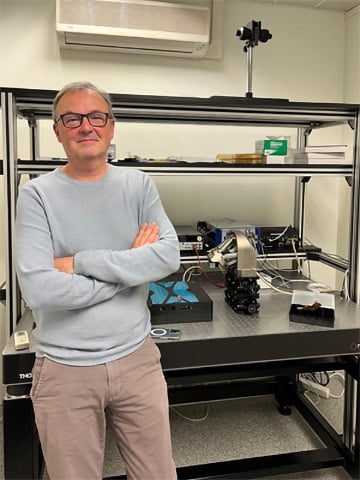
A team from Universitat Politècnica de València and iPRONICS has developed the world’s first programmable and multifunctional photonic chip, enhancing data flow management in telecommunications and AI systems. (Artist’s concept). Credit: SciTechDaily.com
A collaborative team from UPV and iPRONICS has developed the market’s first universal, programmable, and multifunctional photonic chip.
Researchers from the Photonics Research Laboratory (PRL)-iTEAM at the Universitat Politècnica de València, in collaboration with iPRONICS, have developed a groundbreaking photonic chip. This chip is the world’s first to be universal, programmable, and multifunctional, making it a significant advancement for the telecommunications industry, data centers, and AI computing infrastructures. It is poised to enhance a variety of applications including 5G communications, <span class="glossaryLink" aria-describedby="tt" data-cmtooltip="
” data-gt-translate-attributes=”[{"attribute":"data-cmtooltip", "format":"html"}]” tabindex=”0″ role=”link”>quantum computing, data centers, artificial intelligence, satellites, drones, and autonomous vehicles.
The development of this revolutionary chip is the main result of the European project UMWP-Chip, led by researcher José Capmany and funded by an ERC Advanced Grant from the European Research Council. The work has been published in the <span class="glossaryLink" aria-describedby="tt" data-cmtooltip="
” data-gt-translate-attributes=”[{"attribute":"data-cmtooltip", "format":"html"}]” tabindex=”0″ role=”link”>Nature Communications journal.
Chip’s Functionality and Application
The chip devised and manufactured by the UPV and iPRONICS team allows on-demand programming and interconnecting of wireless and photonic segments of communication networks, avoiding the generation of bottlenecks that can limit both the capacity and bandwidth available.
“It is the first chip in the world with these characteristics. It can implement the twelve basic functionalities required by these systems and can be programmed on demand, thus increasing the efficiency of the circuit,” explains Capmany.
The UPV professor, an international reference in the field of photonics, explains that applications such as 5G or autonomous cars require a higher frequency, making it necessary to reduce the size of the antennas and the associated circuits. In this case, the PRL-iTEAM from UPV has managed to make the converter behind the antenna, an interface chip, as tiny and compact as possible and ready to support current and expected future frequency bands.
This chip has already been integrated into an iPRONICS product, the Smartlight, and Vodafone has already used it in testing.
“For us, the development of this chip is a crucial step because it has allowed the validation of our developments applied to a growing problem, the efficient management of data flows in data centers and networks for artificial intelligence computing systems. Our next goal is to scale the chip to meet the needs of this market segment,” said Daniel Pérez-López, co-founder and CTO of iPronics.
Reference: “General-purpose programmable photonic processor for advanced radiofrequency applications” by Daniel Pérez-López, Ana Gutierrez, David Sánchez, Aitor López-Hernández, Mikel Gutierrez, Erica Sánchez-Gomáriz, Juan Fernández, Alejandro Cruz, Alberto Quirós, Zhenyun Xie, Jesús Benitez, Nandor Bekesi, Alejandro Santomé, Diego Pérez-Galacho, Prometheus DasMahapatra, Andrés Macho and José Capmany, 20 February 2024, Nature Communications.
DOI: 10.1038/s41467-024-45888-7

